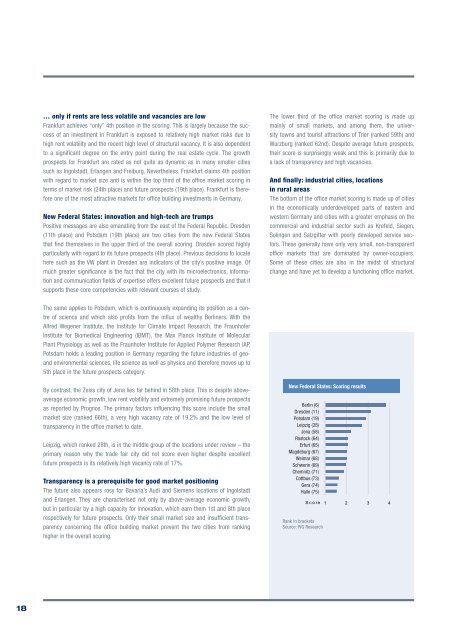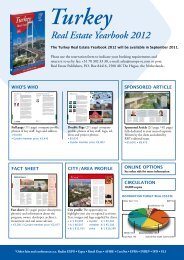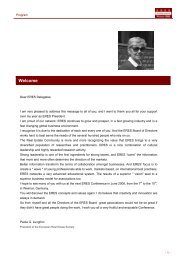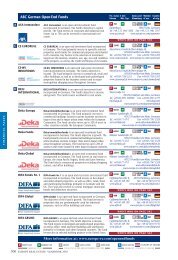Market Report 2011 GerMany - Europe Real Estate
Market Report 2011 GerMany - Europe Real Estate
Market Report 2011 GerMany - Europe Real Estate
You also want an ePaper? Increase the reach of your titles
YUMPU automatically turns print PDFs into web optimized ePapers that Google loves.
18<br />
… only if rents are less volatile and vacancies are low<br />
Frankfurt achieves “only” 4th position in the scoring. This is largely because the success<br />
of an investment in Frankfurt is exposed to relatively high market risks due to<br />
high rent volatility and the recent high level of structural vacancy. It is also dependent<br />
to a significant degree on the entry point during the real estate cycle. The growth<br />
prospects for Frankfurt are rated as not quite as dynamic as in many smaller cities<br />
such as Ingolstadt, Erlangen and Freiburg. Nevertheless, Frankfurt claims 4th position<br />
with regard to market size and is within the top third of the office market scoring in<br />
terms of market risk (24th place) and future prospects (19th place). Frankfurt is therefore<br />
one of the most attractive markets for office building investments in Germany.<br />
New Federal States: innovation and high-tech are trumps<br />
Positive messages are also emanating from the east of the Federal Republic. Dresden<br />
(11th place) and Potsdam (19th place) are two cities from the new Federal States<br />
that find themselves in the upper third of the overall scoring. Dresden scored highly<br />
particularly with regard to its future prospects (4th place). Previous decisions to locate<br />
here such as the VW plant in Dresden are indicators of the city’s positive image. Of<br />
much greater significance is the fact that the city with its microelectronics, information<br />
and communication fields of expertise offers excellent future prospects and that it<br />
supports these core competencies with relevant courses of study.<br />
The same applies to Potsdam, which is continuously expanding its position as a centre<br />
of science and which also profits from the influx of wealthy Berliners. With the<br />
Alfred Wegener Institute, the Institute for Climate Impact Research, the Fraunhofer<br />
Institute for Biomedical Engineering (IBMT), the Max Planck Institute of Molecular<br />
Plant Physiology as well as the Fraunhofer Institute for Applied Polymer Research IAP,<br />
Potsdam holds a leading position in Germany regarding the future industries of geo-<br />
and environ mental sciences, life science as well as physics and therefore moves up to<br />
5th place in the future prospects category.<br />
By contrast, the Zeiss city of Jena lies far behind in 58th place. This is despite aboveaverage<br />
economic growth, low rent volatility and extremely promising future prospects<br />
as reported by Prognos. The primary factors influencing this score include the small<br />
market size (ranked 66th), a very high vacancy rate of 19.2% and the low level of<br />
transparency in the office market to date.<br />
Leipzig, which ranked 28th, is in the middle group of the locations under review – the<br />
primary reason why the trade fair city did not score even higher despite excellent<br />
future prospects is its relatively high vacancy rate of 17%.<br />
Transparency is a prerequisite for good market positioning<br />
The future also appears rosy for Bavaria’s Audi and Siemens locations of Ingolstadt<br />
and Erlangen. They are characterised not only by above-average economic growth,<br />
but in particular by a high capacity for innovation, which earn them 1st and 8th place<br />
respectively for future prospects. Only their small market size and insufficient transparency<br />
concerning the office building market prevent the two cities from ranking<br />
higher in the overall scoring.<br />
The lower third of the office market scoring is made up<br />
mainly of small markets, and among them, the university<br />
towns and tourist attractions of Trier (ranked 59th) and<br />
Wurzburg (ranked 62nd). Despite average future prospects,<br />
their score is surprisingly weak and this is primarily due to<br />
a lack of transparency and high vacancies.<br />
And finally: industrial cities, locations<br />
in rural areas<br />
The bottom of the office market scoring is made up of cities<br />
in the economically underdeveloped parts of eastern and<br />
western Germany and cities with a greater emphasis on the<br />
commercial and industrial sector such as Krefeld, Siegen,<br />
Solingen and Salzgitter with poorly developed service sectors.<br />
These generally have only very small, non-transparent<br />
office markets that are dominated by owner-occupiers.<br />
Some of these cities are also in the midst of structural<br />
change and have yet to develop a functioning office market.<br />
New Federal States: Scoring results<br />
Berlin (6)<br />
Dresden (11)<br />
Potsdam (19)<br />
Leipzig (28)<br />
Jena (58)<br />
Rostock (64)<br />
Erfurt (65)<br />
Magdeburg (67)<br />
Weimar (68)<br />
Schwerin (69)<br />
Chemnitz (71)<br />
Cottbus (73)<br />
Gera (74)<br />
Halle (75)<br />
Score<br />
Rank in brackets<br />
Source: IVG Research<br />
1 2 3 4









